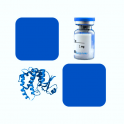
- Remove this product from my favorite's list.
- Add this product to my list of favorites.
Products
Newsletter
 |  |  |  |  |  |

Background:
ErbB3, also known as Her3 (human epidermal growth factor receptor 3), is a member of the epidermal growth factor receptor(EGFR) family of receptor tyrosine kinases. This membrane-bound glycoprotein has a neuregulin binding domain but has not an active kinase domain. It therefore can bind the ligand but cannot mediate the intracellular signal transduction through protein phosphorylation. However, it does form heterodimers with ErbB2 or other EGFR members responsible for tyrosine phosphorylation to give a receptor complex and initiate the related pathway, which lead to cell proliferation or differentiation. Overexpression of this protein has been reported in numerous cancers, including prostate, bladder, and breast tumors. This protein has different isoforms derived from alternative splicing variants, and among which, the secreted isoform lacking the intermembrane region modulates the activity of membrane-bound form.
Source
MABSol® Recombinant Biotinylated Human ErbB3, His Tag, primary amine labeling (ER3-H8223) is expressed from human HEK293 cells. It contains AA Ser 20 - Thr 643 (Accession # NP_001973.2). It is the biotinylated form of Human ErbB3, His Tag (ER3-H5223).
Predicted N-terminus: Ser 20
Molecular Characterization
This protein carries a polyhistidine tag at the C-terminus.
The protein has a calculated MW of 69.5 kDa. The protein migrates as 85-95 kDa under reducing (R) condition (SDS-PAGE) due to glycosylation.
Biotinylation
The primary amines in the side chains of lysine residues and the N-terminus of the protein are conjugated with biotins using standard chemical labeling method. A standard biotin reagent (13.5 angstroms) is used in this product.
Passed as determined by the HABA assay / binding ELISA.
Endotoxin
Less than 1.0 EU per μg by the LAL method.
Purity
>95% as determined by SDS-PAGE.
>90% as determined by SEC-MALS.
Formulation
Lyophilized from 0.22 μm filtered solution in PBS, pH7.4 with trehalose as protectant.
Reconstitution
Please see Certificate of Analysis for specific instructions.
For best performance, we strongly recommend you to follow the reconstitution protocol provided in the CoA.
Storage
For long term storage, the product should be stored at lyophilized state at -20°C or lower. Please avoid repeated freeze-thaw cycles.
This product is stable after storage at:
-20°C to -70°C for 12 months in lyophilized state;
-70°C for 6 months under sterile conditions after reconstitution.
Bioactivity
Please refer to product data sheet.
(1) "HER3 (ERBB3) amplification in liposarcoma - a putative new therapeutic target?"
Becker, Puladi, Xie et al
World J Surg Oncol (2024) 22 (1), 131
(2) "Gastric cancer actionable genomic alterations across diverse populations worldwide and pharmacogenomics strategies based on precision oncology"
Echeverría-Garcés, Ramos-Medina, Vargas et al
Front Pharmacol (2024) 15, 1373007
(3) "Based on Immune Microenvironment and Genomic Status, Exploring Immunotherapy in Advanced Hidradenocarcinoma: A Retrospective Analysis"
Lin, Zhu, Chen et al
Acta Derm Venereol (2024) 104, adv22146
Showing 1-3 of 2758 papers.
Recombinant human ERBB2 (HER2, HER-2), protein kinase domain, 10 µg - 385,00 €
Recombinant Mouse ErbB2/HER2 Protein, His Tag, 100µg - 455,00 €
Recombinant human EGFR /ErbB1 Protein, His Tag, 100µg - 481,00 €
Recombinant human ErbB-3 /HER3 Protein, His Tag, 100µg - 338,00 €
Recombinant human ErbB-3/HER3 Protein, 200µg - 442,00 €
Follow us